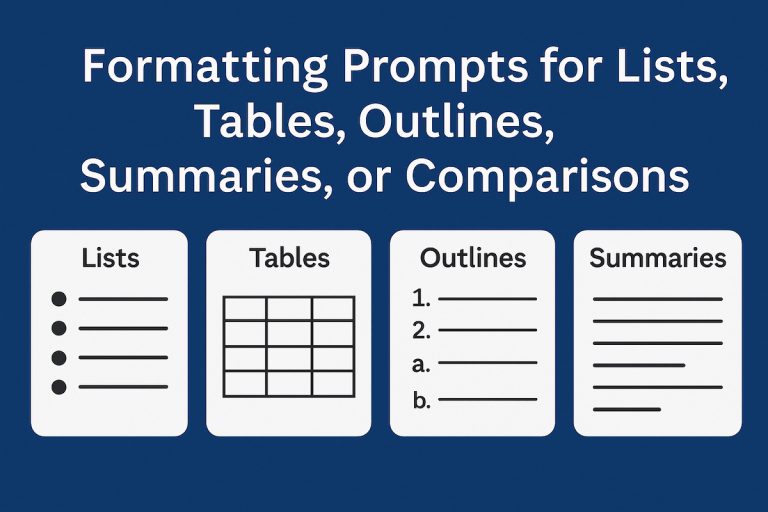Prompt Essentials – Master the Art of Writing Clear, Effective Prompts
When it comes to getting great responses from AI chatbots like ChatGPT, the secret lies in the prompt. Think of your prompt as the question or instruction you give the AI – the clearer and more intentional it is, the better the result. But crafting effective prompts is more than just typing a question; it’s an essential skill that can dramatically improve your experience and productivity with AI.
In this article, we’ll break down the core components of strong prompts, show you practical examples, and provide techniques that anyone – even a beginner – can use to master the art of prompt writing.
What Is a Prompt?
At its most basic, a prompt is simply a message or instruction you give to the chatbot to start the conversation. But not all prompts are created equal. For example:
- Weak prompt: “Write something about marketing.”
- Strong prompt: “Write a 500-word article introducing digital marketing to small business owners, using a friendly tone.”
Notice how the second prompt is specific, has a target audience, tone, and length? That’s what we’re aiming for – clarity and intent.
The Building Blocks of a Good Prompt
There are a few key elements that make a prompt effective:
1. Clarity
The AI needs to know what you want. Avoid vague wording and be direct about your goal. Instead of asking “Tell me something interesting,” you could say “Tell me an interesting fact about African elephants.”
2. Context
Help the AI understand the background or purpose. For example, “Act as a travel blogger writing about a trip to Thailand” gives the AI a role and a theme.
3. Format
If you want the response to follow a specific structure – like a list, an article, or a dialogue — say so. For instance, “List 5 tips for staying productive while working from home.”
4. Tone or Style
You can ask the AI to be formal, friendly, humorous, technical, or anything else. Example: “Write a professional email to a client explaining a project delay.”
5. Constraints
These can include length, word choice, or even reading level. For example, “Summarize this news article in under 100 words for a 12-year-old.”
Prompt Templates You Can Use
To make things easier, here are a few prompt templates you can start using right away:
- Instructional: “Explain [topic] to someone with no background in [field].”
- Creative: “Write a short story about [character/situation] in the style of [author/genre].”
- Analytical: “Compare the pros and cons of [Option A] and [Option B] for [specific use case].”
- Role-playing: “Act as a business consultant. I’ll describe my business, and you’ll give advice.”
- Rewriting: “Rewrite the following paragraph in simpler language/more formal tone/more persuasive language.”
Try experimenting with these structures to see how they change the AI’s response.
Examples of Improved Prompting
Let’s look at a few before-and-after examples to show how better prompting makes a difference.
Example 1:
- Before: “Tell me about Paris.”
- After: “Give me a short travel guide for first-time visitors to Paris, including best times to go, top 3 attractions, and local food to try.”
Example 2:
- Before: “Help with a CV.”
- After: “Help me write a professional CV summary for a junior graphic designer with 2 years of freelance experience and strong Adobe skills.”
Example 3:
- Before: “Write something about AI.”
- After: “Write a 500-word blog post that explains what AI is, its benefits, and how small businesses can use it, written in a simple, engaging tone for beginners.”
The difference in response quality is huge, and all it takes is a few extra seconds of thoughtful prompt writing.
Advanced Prompting Techniques
Once you’re comfortable with the basics, you can explore a few more advanced techniques:
1. Chain-of-Thought Prompts
Ask the AI to “think step by step” before answering. This helps with logic-heavy questions or problem-solving tasks.
Prompt example: “You are an expert math tutor. Explain step-by-step how to solve this equation…”
2. Few-Shot Prompting
Give the AI a few examples before asking for a response in the same pattern.
Prompt example: “Here are three headlines for a blog about gardening. Now write three more.”
- How to Grow Tomatoes in Containers
- 5 Mistakes New Gardeners Make
- The Secret to Thriving Indoor Herbs
(AI continues…)
3. Iterative Prompting
Start with a rough prompt, then refine your request based on the response. You can say things like, “Make it more concise” or “Add a quote.”
Common Mistakes to Avoid
Even experienced users sometimes fall into these common traps:
- Being too vague: “Write something for my blog.” → What topic? What audience? What length?
- Asking multiple things at once without clarity: “Can you summarize and also make it catchy and SEO-friendly and maybe a tweet too?”
- Forgetting to define the audience: Knowing who the content is for changes everything.
- Expecting magic without guidance: AI is powerful, but it’s not psychic. Help it help you.
Final Thoughts
Learning to write better prompts is like learning a new language one that helps you communicate clearly with AI. The more specific and intentional you are, the more useful, accurate, and creative the responses will be.
Think of your prompt as a tool not just a question. And like any tool, the more skillfully you use it, the more impressive the results.
Whether you’re writing blog content, solving problems, generating ideas, or just exploring what AI can do, strong prompts are the key to unlocking its full potential.








